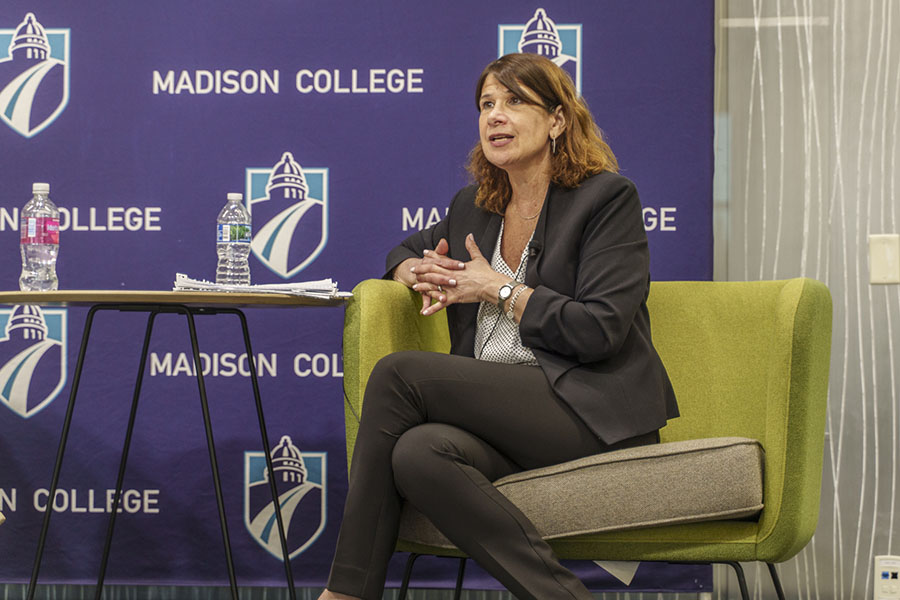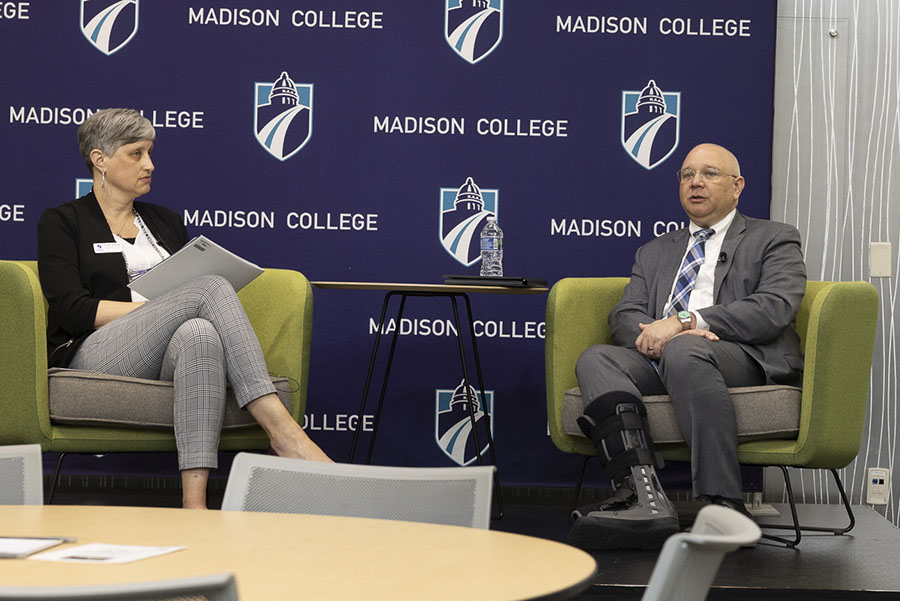When I gave birth to my first child, Ador, in 2021, I quit my job because I felt guilty about leaving my 3-month-old son. I had struggled with infertility and having a baby was a dream come true.
With my first pregnancy with Ador, I struggled with post-partum depression. Ironically, it was that struggle that helped me through my second pregnancy with my second son, Bjorn. When Bjorn was born, the stress I had about whether I was doing everything right lifted. I love being their mom.
But even with the joys of being my boy’s full-time mother, the toll was more than I expected. I was constantly drained, never sleeping more than three hours. The boys needed me, so my education goal took a backseat.
I finally returned to school, choosing Madison College to pursue a Liberal Arts Science and Technology degree, with the goal of entering the Surgical Technologist Program. I appreciated the college’s diverse platform offerings, and I made sure to focus on online classes so I could be with my children, giving them stability. My advisor ensured my success by offering me online classes to make childcare work. I am forever grateful.
Other moms join me in trying to find balance in childcare, work and school. In today’s world, stay-at-home mothers now juggle full-time caregiving responsibilities while also pursuing higher education. Some of my full-time mom friends are enrolled in school and work from home. When connect, we can tell our emotional and mental load is through the roof. We all look forward to a child-free day to get together, but our guilt always kicks in too because we know how much our children rely on us.
While this dual role can be deeply fulfilling, it demands resilience and endurance that often goes unrecognized. The unique challenges these mothers face include emotional strain, cognitive overload and societal misconceptions, highlighting the need for community, friends and family support.
Stay-at-home mothers are expected to be the emotional anchors of their families, providing comfort, structure and stability. Arlie Russell Hochschild and Anne Machung in their book, “The Second Shift: Working Families and the Revolution at Home (2012),” suggest that emotional labor involves managing one’s emotions to maintain harmony in personal and professional environments. This concept is relevant for mothers who must balance personal aspirations with their family’s emotional needs.
This work doesn’t end when students join online classes or study for an exam. Instead, it intertwines with their academic responsibilities, creating an invisible yet overwhelming burden. Many mothers feel immense guilt for spending time on their studies rather than being fully present for their children, as confirmed by developmental scientists Suniya Luthar and Lucia Ciciolla in their article “Who Mothers Mommy? Factors That Contribute to Maternal Well-Being” (Journal of Developmental Psychology).
I know that the pressure to perform well in both roles lead to anxiety and self-doubt, making emotional regulation an ongoing struggle. With my son Ador I struggled with post-partum depression because I didn’t know what I was doing as a first-time mother. No one tells you the difficulty of the first few months and that you cannot just jump back into work, school, household chores and your daily routine. You must adjust to what is best for you and the baby.
Of course, my boys come first. When they are awake, I play with them, prepare meals, schedule doctor appointments, complete housework and support their growth.
After I tuck them into bed, I can finally do my homework working as late as needed. Sometimes faculty check in with me if they notice assignments posted in the late evening or early morning hours.
Managing is a chore. I have found myself making checklists and having a refrigerator calendar that has helped me ensure I am getting everything done.
For some student-parents, this ongoing juggling act can lead to decision fatigue and burnout. Some are told that they look tired or have a short temper. My stay at home, work from home, online school mom friends all have expressed frustration over similar comments, when the only comment we want to hear is there anything we can do to help you.
Societal expectations worsen the perception that stay-at-home parents have an abundance of free time, leading to unrealistic expectations and assumptions. This misconception can lead to feelings of isolation, guilt and frustration. Some friends and family have mentioned they wish they could be a stay-at-home parent. They think I have it easy when I barely have time for a shower. The biggest guilt is knowing your partner is the only source of income.
In addition, we miss having adult conversations. The village we dreamed of having isn’t there. My village includes two friends I have known since immigrating to the U.S, one is a classmate and another is a former coworker. We Facetime weekly, sharing our mental and feelings to keep us feeling sane.
Furthermore, many educational institutions are not designed with nontraditional students in mind. Research by the Manhattan Institute (2025) highlights that higher education policies often cater to younger, full-time students rather than adult learners who balance caregiving responsibilities. The lack of flexibility in scheduling, limited access to childcare and the financial strain of tuition further complicates our journeys.
Families and partners can support parent-students by actively sharing household responsibilities and providing emotional encouragement. My in-laws visited from Europe for a month and the mental load they took off me by helping with the kids, cleaning, cooking and letting me sleep in, was massive.
With the right institutional, societal and familial support, stay-at-home mothers can successfully navigate both their academic and caregiving responsibilities.
The toll of being a stay-at-home student mom
Suada Murseli, Contributor
April 8, 2025
Suada Murseli and her family pose for a photo in front of the Big Ben Clock tower in the UK.
Story continues below advertisement


























